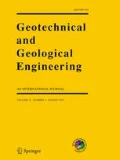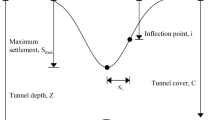Abstract
Uncertainty of properties of improved soft ground with chemical grouting often results in discrepancy between simulated results and observed data and makes prediction for ground subsidence difficult. It also made practice usually adopts unconfined compressive strength of soil–cement mixtures as design control criterion. This paper presents a methodology to interpret the strength and deformation parameters from unconfined compressive strength of soil–cement mixtures for advanced numerical analysis which is widely used in reinforcing the soft ground and pre-supporting excavation. Observed data are used to compare with the simulated results and validate the interpretations. Numerical experiments with two-dimensional finite element model for covered undercutting of large cross-sectional twin tunnel under an existing subway station are presented. Issues with respect to design and construction of excavation that potentially affect the ground surface subsidence are explored. It was found that the ground subsidence caused by tunneling in soil–cement medium under existing subway station is similar to that in a greenfield site but with flatter settlement trough. Unconfined compressive strength of soil–cement mixtures ranging from 1.5 to 2.0 MPa can significantly reduce the settlement to an acceptable control criterion. Settlement magnitude is influenced by pillar width but not obviously by the location of umbrella arch installed in twin tunnels.













Similar content being viewed by others
References
Addenbrook TI, Potts DM (2001) Twin tunnel interaction: surface and subsurface effects. Int J Geomech 1(2):249–271
Aksoy CO, Onargan T (2010) The role of umbrella arch and face bolt as deformation preventing support system in preventing building damages. Tunn Undergr Space Technol 25:553–559
American Concrete Institute (2003) Building code requirements for structural concrete and commentary (ACI 318-03)
Balmer GG (1958) Shear strength and elastic properties of soil-cement mixtures under triaxial loading. Reprint from the copyrighted Proceedings of American Society for testing materials by Portland cement association, Research and Development Laboratories, pp 1187–1204
Bieniawski ZT (1992) Design methodology in rock engineering. Taylor & Francis, New York
Ghaboussi J, Ranken RE (1977) Interaction between two parallel tunnels. Int J Numer Anal Methods Geomech 1:75–103
Leca E, New B (2007) Settlement Induced by tunneling in soft ground. Tunn Undergr Space Technol 22:119–149
Leca E, Leblais Y, Kuhnhenn K (2000) Underground works in soils and soft rock tunneling. Keynote speech, Proceedings of international conference on geotechnical and geological engineering, vol 1, pp 220–268, Melbourne, Australia
Lee FH, Lee Y, Chew SH, Yong KY (2005) Strength and modulus of marine clay-cement mixes. J Geotech Geoenviron Eng 131(2):178–186
Li JJ, Liang RW (2009) Research on compression strength and modulus of deformation of cemented soil. Chin J Rock Soil Mech 30(2):473–477 (in Chinese)
Lorenzo G, Bergado DT (2006) Fundamental characteristics of cement-admixed clay in deep mixing. J Mater Civ Eng 18:161–174
Mitchell JK (1976) The properties of cement-stabilized soils. In: Proceedings of residential workshop on materials and methods for low cost road, rail, and reclamation works, pp 365–404, Leura, Australia
Munfakh GA (1997a) The ground improvement engineering—the state of the US practice: part 1. Methods. Ground Improv 1(4):193–214
Munfakh GA (1997b) The ground improvement engineering—the state of the US practice: part 2. Applications. Ground Improv 1(4):215–222
Ng CWW, Lee KM, Tang DKW (2004) Three-dimensional numerical investigations of New Austrian Tunneling Method (NATM) twin tunnel interactions. Can Geotech J 41:523–539
Porbaha A (1998) State of the art in deep mixing technology. Part I: basic concepts and overview. Ground Improv 2:81–92
Tang Y, Liu H, Zhu W (2000) Engineering properties of soil–cement mixes. Chin J Geotech Eng 22(5):549–554 (in Chinese)
Uddin K, Balasubramaniam AS, Bergardo DT (1997) Engineering behaviors of cement-treated Bangkok soft clay. Geotech Eng J 28(1):89–119
Valizadeh Kivi A, Sadaghiani MH, Ahmadi MM (2012) Numerical modeling of ground settlement control of large span underground station in Tehran Metro using Central Beam Column (CBC) structure. Tunn Undergr Space Technol 28:1–9
Wang G (2010) Construction of twin large cross-section mined tunnels adjacent to existing metro line. Tunn Constr 8(30):365–370 (in Chinese)
Wang DY, Gao ZR, Lee LJ, Gao W (2013) Assessment and optimization of soil-mixing and umbrella vault applied for a cross-passage excavation in soft soils. ASCE Int J Geomech. doi:10.1061/(ASCE)GM.1943-5622.0000374
Yang B, Gu X, Huang Y et al (2006) Strength properties of mixes of soil-cement. Chin J Highw 7:130–136 (in Chinese)
Yoo C (2002) Finite-element analysis of tunnel face reinforced by longitudinal pipes. Comput Geotech 29:73–94
Zhang L, Einstein HH (2004) Using RQD to estimate the deformation modulus of rock masses. Int J Rock Mech Min Sci 41:337–341
Author information
Authors and Affiliations
Corresponding author
Rights and permissions
About this article
Cite this article
Wang, D., Olowokere, D. & Zhang, L. Interpretation of Soil–Cement Properties and Application in Numerical Studies of Ground Settlement Due to Tunneling Under Existing Metro Line. Geotech Geol Eng 32, 1275–1289 (2014). https://doi.org/10.1007/s10706-014-9803-2
Received:
Accepted:
Published:
Issue Date:
DOI: https://doi.org/10.1007/s10706-014-9803-2




